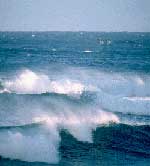 |
 |
|

| user: anonymous
|
 |
![]()
|
|
Following are quotations from research concerning the potential production and activity of antibiotic, antibacterial, antimicrobial, antifungal, and antiviral substances in seaweeds. These have been taken from a number of reports, quotations and bibliographies of which some are given here. Space does not permit presentation of these reports in their totality. Time here does not permit us to go on and on with quotations and many studies have been prepared and completed on the various antibacterial, antimicrobial, antibiotic and antiviral properties of sea plants. The files and research papers contained in the Josephine E. Tilden Memorial Museum and Library contain numerous reports on testing performed and completed in these areas. It should be noted here that these compounds are found in the sea plants used in The Wachters' Blend of Marine Algae.
- "If we take inventory of the more than 40,000 species of land plants of which at least 10,000 have been chemically and pharmacologically screened in one way or another, our record of success has been somewhat impressive. Should not the carbohydrates, amino acids, biotoxins, enzymes, steroids, and other chemical products of the sea have similar therapeutic uses in pharmacy and medicine? The gains from the years of studies with land organisms from chemical isolation of pharmacologistical evaluation and more sophisticated equipment than that which is now available in the modern laboratory for these studies are surely assets in our turn to the resources of the sea. We must now organize the search more effectively for the therapeutic agents which the oceans will surely yield." Sources of Drugs from the &a in their Drug Screening, Herbert W. Youngken, Jr., Dean, College of Pharmacy and Professor of Pharmacognosy, University of Rhode Island. Excerpts from Drugs From the Sea.
- "In the protistans, which include the red, brown, and green algae, the diatoms and dianoflagellets, there are many members possessing a wide range of pharmacological activity. Generally the red, brown and green algae contain useful phycocolloids and vitamins and some contain antibiotic principals."
- "Digena simplex has yielded kainic acid, a valuable Vermifuge or anthelmintic against the parasitic round worm, Acaras lumbircoides, the whit worm, Trichuris trichura and tape worm, Taipia supp."
- "Another seaweed Laminaria coloustoni species yield the polysaccharide, laminarin, which consists essentially of B-B-Glucose residues. The highly sulfated derivities of Laminarin have anticoagulant properties comparable to heperin."
- "One unique use of sodium alginate is seen in its availability to inhibit uptake of radiostrontium for the human gastrointestinal tract. In human test, 0.36 microcurides of Sr 85 was administered orally 20 minutes after an oral administration of ten grams of sodium alginate. Twenty-six days later, 0.48 microcurides of Sr 85 was given orally. In both phases of the experiment, samples of excreta and blood were collected in the body retention of Sr 85 as measured by means of Windscale whole body counter. Based on blood plasma, urine and body retention measurements, sodium alginate reduced the uptake of radiostrontium from the gastrointestinal tract by a factor of about 9. This discovery is of great importance and Sr 90 is probably the most hazardous of all long lived fission products occurring in nuclear weapon fallout. The use of sodium alginate appears to be able to remove this contaminant from the body without seriously effecting the availability of calcium, sodium or potassium to the body." Hesp, Et Al. Taken from current status of drug compounds from marine sources. A. R. DerMarderosian, Ph.D., Philadephia College of Pharmacy and Science.
- "Kamimoto showed that seaweed extracts inhibit the growth of pathogenic bacteria. In studies of the antibacterial activity of other extracts obtained from British seaweed Chester and Stott found Halidrys siliquosa, Pelvetia canaliculata, Laminaria digitata and Polysiphonia fastigiata especially noteworthy."
- "There has been a considerable interest in characterising the antimicrobial substances responsible for the reported activities of diverse marine seaweeds through either extracts of the brown Sargassum netans, and Chondria littoralis were studied with alumina and paper chromatography by Martinex Nadal and Co-workers."
- "Volatile organic acids called the "Sargano small complex" were prepared and demonstrated to have broad-spectrum antibacterial and antifungal activity as well as cytotoxic activity against K B tumor cells. " Quoted from Antimicrobial Substances from the Sea, Paul Burkholder, Lamont Geological Observatory of Columbia University Palisades, New York.
- "In bone grafts already sulfated polysacchardoids from seaweeds have been used in films which are placed between the bones to be grafted so that the growth of connective tissue will be stimulated in the graft will start growing together in a more rapid pace than normal."
- "Seaweed sulfated polysaccharides increase the growth of connective tissue in collagen and it has been shown that the sulfated polysaccharides of the body must be involved in connective tissue growth in some manner. Experiments have shown that the sulfated polysaccharides may be involved in arthritis and are active in promoting and helping the healing process of the body (Highton)."
- "In experimental work it was noticed that carragenan (extract of red algae) among other sulfated polysacchardois protected guinea pigs from ulcers produced by injection of histamine."
- "It was also expounded that carragenan reacted with the mucoid lining of the stomach and gave a protective layer through which pepsin and acid has difficulty in passing." From the use of seaweed extracts in the fields of food and medicine. Sydney D. Upham, Rockland, Maine.
The Secrets of the Wachters' Exclusive Blend of Sea Plants™
The Wachters' Exclusive Blend of Sea Plants™
This site powered by FallingApple.com SiteTools 3.0 & owned and operated by Triune-Being Research Organization Ltd.
